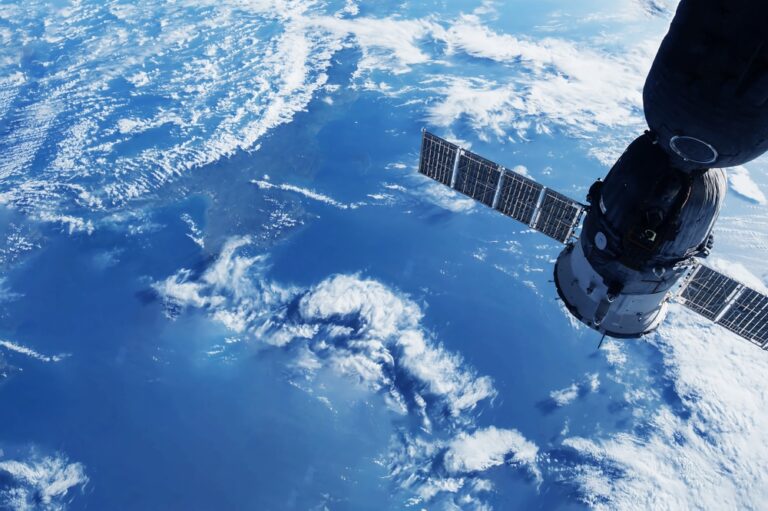- Blogs
- Space Applications
case study
Methane Monitoring
Satellite-derived data offers UK organisations additional data to identify and mitigate against harmful greenhouse gas emissions.

Introduction
This Methane Monitoring Data Supply for UK programme, is a partnership between the Satellite Applications Catapult and GHGSat, funded by the UK Space Agency, which will provide UK organisations with access to high-resolution methane emissions satellite data.
This programme will address the gap in the UK market for understanding and valuing the benefits of satellite derived greenhouse gas (GHG) data.
- Project Funder: UK Space Agency
- Project Start: June 2023
- Project Finish: March 2025
Methane has a more powerful effect on global warming than carbon dioxide and by taking action to identify emissions, we can reduce atmospheric concentrations, which contribute to warming.
About The Data
Satellite-derived data offers organisations a way to reliably measure their (and their supply chain) GHG emissions and implement outcomes that tackle these activities.
This programme will offer UK organisations access to:
- Assess the data and identify use cases.
- Archive methane data for research & development – UK organisations can access GHGSat archive data for research and development purposes
- Satellite tasking – UK organisations may make satellite tasking requests (subject to qualifying criteria).
- Support and Engagement – Organisations in high emitting sectors can receive support to help them to fully realise the value (and benefits) of satellite data and the methane emissions archive dataset.
- Community of users – Support and advice from likeminded users to increase interest in satellite-derived methane data within your organisation. The Satellite Applications Catapult will support users according to their needs, company size and potential use cases.
- Evidence source – Development of evidence methodology to support compliance of international agreements and domestic net zero policy.
- Blogs
- Sustainable Earth
- Blogs
- Sustainable Earth
Which sectors can the programme help?
Satellite-derived data can support:
- organisations to measure GHG emissions through the supply chain.
- regulatory organisations to demonstrate UK compliance and progress on national and international net zero commitments.
If you work in Agriculture and Farming, Waste Management, Large Industrial Processes or the Oil and Gas sector, this programme offers you a way to identify, validate and monitor GHG emissions.
Satellite-derived data offers you an alternative way to monitor your facilities, particularly difficult to reach sites. With independent, evidence-based outputs, you can develop mitigation and elimination strategies and then monitor their success.
The programme team are ready to support your organisation realise the power of Satellite-derived data in support of your ESG goals.
Programme objectives
The aims of the programme are to:
- Enhance UK influence and reputation as a global leader in the exploitation of satellite-derived data applications and services.
- Champion the benefits of space for UK industries including supporting the realisation of business outcomes and helping to tackle the climate emergency.
- Catalyse investment in satellite-derived data, applications, and services by non-space businesses to grow the market within the period of the project.
About the GHGSat Data
Global methane monitoring data
Through this project, eligible users will have access to a large subset of GHGSat methane monitoring data. These data cover a range of sites of interest across the globe.
Sites of interest were selected across multiple industries, using past studies to identify potential sites where methane emissions are expected to occur. These sites were compared to GHGSat archive imagery, with a final selection of locations based on there being a minimum of one identified emission plume. For each selected location, all detected emission plumes between November 2020 and March 2023 are included in final data selection.
In additions, a smaller subset was recommended by GHGSat, from previous case studies including Coal Mines in China, and Oil and Gas Flare stacks in Algeria and Egypt. All archive observations over the UK are also provided.
Data types and geographical distribution
This dataset includes measurements from 1,337 satellite observations across 424 specific sites across all major continents around the globe. These data include 1,546 individually identified Emission plumes and 443 full scene (12 km2) background methane Abundance data.
Industry sectors
The 1,337 observations have been selected to cover a range of industries, including:
Agriculture
- Livestock farming
- Abattoirs
Extractive industries
- Coal and mineral Mining,
- Oil and Gas drilling and pipelines
- Flare stack, excess gas burning
Landfills
- Known large landfill sites designated by region (EU, USA, Global)
European sites also include Waste Water Treatment facilities.

For Existing Users
SPECTRA and data access will continue until 1 April 2026, with ongoing support from GHGSat. If you have any issues or requests, please contact CH4.data@sa.catapult.org.uk.
- Government and OS Users: data can be used in perpetuity (but must be downloaded before 1 April 2026)
- Non-Government Users: SPECTRA access closed and local data copies should be deleted as of 1 April 2026




